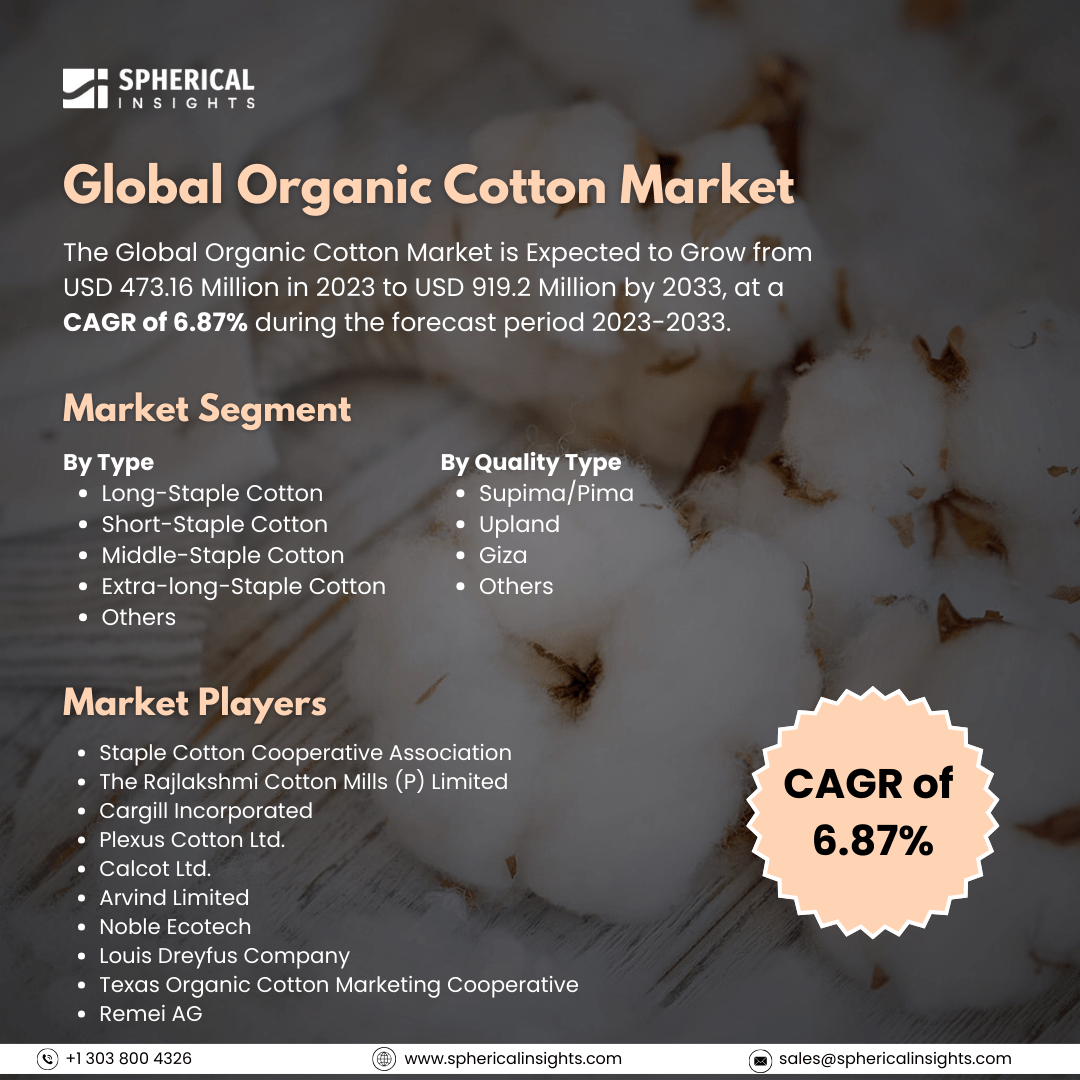Global Organic Cotton Market Size to Exceed USD 919.2 Million by 2033
According to a research report published by Spherical Insights & Consulting, The Global Organic Cotton Market is Expected to Grow from USD 473.16 Million in 2023 to USD 919.2 Million by 2033, at a CAGR of 6.87% during the forecast period 2023-2033.
Browse 210 Market Data Tables and 45 Figures Spread Through 190 Pages and In-Depth TOC On the Global Organic Cotton Market Size, Share, and COVID-19 Impact Analysis, By Type (Long-Staple Cotton, Short-Staple Cotton, Middle-Staple Cotton, Extra-long-Staple Cotton, and Others), By Quality Type (Supima/Pima, Upland, Giza, and Others), By Application (Apparel, Packaging, and Others), and By Region (North America, Europe, Asia-Pacific, Latin America, Middle East, and Africa), Analysis and Forecast 2023 - 2033.
Cotton that is grown with natural fertilizers and products that have less of an adverse effect on the environment is known as the organic cotton market. The production process creates more diverse agriculture, replenishes and preserves soil fertility, and uses fewer harmful pesticides and fertilizers. High-quality seeds, such as genetically modified ones, are used to grow this kind of cotton to improve and increase crop productivity. The market is being served by the increase in textile product consumption brought on by quick fashion as well as the need for sustainable alternatives. Furthermore, this is due to growing worldwide concerns about pollution and sustainability many businesses prefer using organic cotton when producing textiles. This kind of cotton is better for soil conditioning and has a smaller environmental impact than conventional cotton, which utilizes hazardous pesticides and needs a lot of water. However, this is because of the significant costs associated with growing cotton and the lack of advanced technology for crop yield management organic cotton is typically more expensive than its conventional counterparts.
The middle-staple cotton segment held the largest share in 2023 and is estimated to grow at a CAGR of 6.5% during the projected period.
Based on the material, the global organic cotton market is categorized into long-staple cotton, short-staple cotton, middle-staple cotton, extra-long-staple cotton, and others. Among these, the middle-staple cotton segment held the largest share in 2023 and is estimated to grow at a CAGR of 6.5% during the projected period. This is because it's used to make wearables like hats, shoes, bags, and clothing. The fibers, which range in length from 0.75 to 1.25, have a variety of qualities that make them suitable for making a variety of clothing types. Furthermore, organic cotton's recyclable qualities lessen its environmental impact, which encourages its use in packaging.
The upland segment held the largest share in 2023 and is anticipated to grow at a CAGR of 6.3% during the forecast period.
Based on the quality type, the global organic cotton market is categorized into supima/pima, upland, giza, and others. Among these, the upland segment held the largest share in 2023 and is anticipated to grow at a CAGR of 6.3% during the forecast period. This is due to the significant demand for short and middle staple fiber for the production of apparel items such as t-shirts, socks, jeans, and scarves, upland cotton has the highest value on the global market. The market is also being driven by several fashion brands that use organic ingredients and have implemented a cleaner and greener garment production process, as well as growing consumer and retailer awareness.
The apparel segment held the largest share in 2023 and is anticipated to grow at a CAGR of 6.1% during the forecast period.
Based on the application, the global organic cotton market is categorized into apparel, packaging, and others. Among these, the apparel segment held the largest share in 2023 and is anticipated to grow at a CAGR of 6.1% during the forecast period. Daily wear, outerwear, and various hair and body accessories are all included in this category. Clothing that is more environmentally friendly and biodegradable has become more popular as a result of governments and consumers becoming more concerned about the environment due to the production of textile waste. The market is being propelled by this rising demand.
Asia Pacific is estimated to hold the largest share of the global organic cotton market over the predicted timeframe.
Asia Pacific is estimated to hold the largest share of the global organic cotton market over the predicted timeframe. This is because many end-use industries, including the medical, clothing, and cosmetics sectors, have a significant demand for sustainable cotton solutions. Their many cotton growers and buyers reside in the area, resulting in cheaper costs for locally produced goods. This contributes to increased product usage and a simpler transition away from traditional cotton.
North America is estimated to grow at the fastest CAGR in the global organic cotton market during the forecast period. This is principally fueled by rising regional consumer demand for eco-friendly and sustainable textiles and a heightened awareness of ethical sourcing methods. Numerous technologies are being created to lessen the waste produced by the beauty and medical industries, and the market is currently opening up as a result of the approach's adoption.
Company Profiling
Major vendors in the global organic cotton market are Staple Cotton Cooperative Association, The Rajlakshmi Cotton Mills (P) Limited, Cargill Incorporated, Plexus Cotton Ltd., Calcot Ltd., Arvind Limited, Noble Ecotech, Arvind Limited, Louis Dreyfus Company, Texas Organic Cotton Marketing Cooperative, Remei AG, and others.
Key Target Audience
- Market Players
- Investors
- End-users
- Government Authorities
- Consulting and Research Firm
- Venture capitalists
- Value-Added Resellers (VARs)
Recent Developments
- In March 2022, the Armorseed firm introduced two cotton varieties: ARMOR 9442 XF and ARMOR 9512 B3XF. Both cultivars are renowned for their large seeds, enhanced fiber quality, vigor/emergence, and XtendFlex Technology.
Market Segment
This study forecasts revenue at global, regional, and country levels from 2020 to 2033. Spherical Insights has segmented the global organic cotton market based on the below-mentioned segments:
Global Organic Cotton Market, By Type
- Long-Staple Cotton
- Short-Staple Cotton
- Middle-Staple Cotton
- Extra-long-Staple Cotton
- Others
Global Organic Cotton Market, By Quality Type
- Supima/Pima
- Upland
- Giza
- Others
Global Organic Cotton Market, By Application
Global Organic Cotton Market, By Regional
- North America
- Europe
- Germany
- UK
- France
- Italy
- Spain
- Russia
- Rest of Europe
- Asia Pacific
- China
- Japan
- India
- South Korea
- Australia
- Rest of Asia Pacific
- South America
- Brazil
- Argentina
- Rest of South America
- Middle East & Africa
- UAE
- Saudi Arabia
- Qatar
- South Africa
- Rest of the Middle East & Africa



